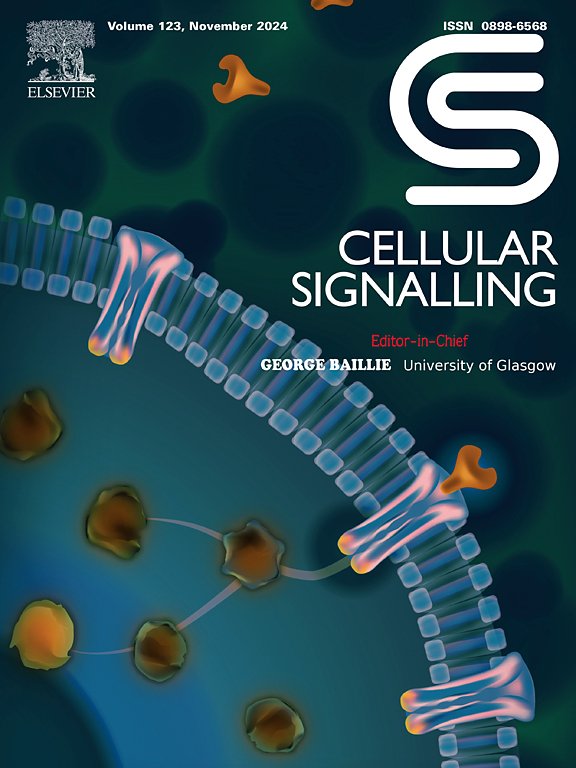EZH2通过E3泛素连接酶HUWE1在心力衰竭中调节c-Myc稳定性的作用及其机制
IF 3.7
2区 生物学
Q2 CELL BIOLOGY
引用次数: 0
摘要
目的:心力衰竭(HF)是死亡率和发病率的主要原因。关于zeste同源物2增强子(EZH2)在HF中的作用,我们研究了EZH2如何通过HUWE1调节c-Myc的稳定性及其机制。方法:采用功能增益和功能丧失法研究EZH2在心衰中的作用。观察小鼠心功能和组织病理学变化。RT-qPCR检测EZH2、HUWE1、c-Myc mRNA水平。采用CCK-8法测定细胞活力。检测HUWE1、EZH2、H3K27me3、c-Myc、房利钠肽(ANP)、脑利钠肽(BNP)、β-肌球蛋白重链(β-MHC)表达,免疫荧光法测定心肌细胞大小。评估炎症因子、TNF-α、IL-6和IL-1β启动子荧光素酶活性及其启动子区域c-Myc的富集程度。我们评估了H3K27me3在HUWE1启动子区域的富集、HUWE1介导的c-Myc泛素化和c-Myc蛋白的稳定性。结果:心衰小鼠心肌组织中EZH2表达上调。血管紧张素II降低细胞活力,增加细胞大小,升高EZH2和c-Myc表达以及ANP、BNP和β-MHC蛋白水平,增强细胞中TNF-α、IL-6和IL-1β水平。EZH2敲低下调的c-Myc,改善心肌细胞肥厚(CH);体内实验证实了这种影响,并通过c-Myc过表达部分避免了这种影响。EZH2通过增强H3K27me3修饰,降低HUWE1表达和c-Myc泛素化,提高c-Myc蛋白的稳定性。HUWE1过表达降低了c-Myc蛋白的稳定性,部分抵消了EZH2敲低对ch的改善作用。结论:EZH2通过促进H3K27me3修饰来抑制HUWE1的转录表达,增强c-Myc蛋白的稳定性,从而促进HF的发生。本文章由计算机程序翻译,如有差异,请以英文原文为准。
Role of EZH2 in regulating c-Myc stability through the E3 ubiquitin ligase HUWE1 in heart failure and its mechanisms
Objective
Heart failure (HF) is a leading cause of mortality and morbidity. Respecting the role of enhancer of zeste homolog 2 (EZH2) in HF, we examined how EZH2 regulated c-Myc stability through HUWE1 and its mechanism.
Methods
Gain- and loss-of-function assays were performed to investigate the role of EZH2 in HF. Cardiac function and histopathological changes in mice were assessed. EZH2, HUWE1, and c-Myc mRNA levels were determined by RT-qPCR. Cell viability was assessed using CCK-8 assay. HUWE1, EZH2, H3K27me3, c-Myc, atrial natriuretic peptide (ANP), brain natriuretic peptide (BNP), and β-myosin heavy chain (β-MHC) expression were detected, followed by immunofluorescence to determine cardiomyocyte size. Inflammatory cytokines, TNF-α, IL-6, and IL-1β promoter luciferase activity, and c-Myc enrichment in their promoter regions were evaluated. H3K27me3 enrichment in the HUWE1 promoter region, HUWE1-mediated c-Myc ubiquitination, and c-Myc protein stability were assessed.
Results
EZH2 was up-regulated in myocardial tissues of HF mice. Angiotensin II reduced cell viability, increased cell size, elevated EZH2 and c-Myc expression and ANP, BNP, and β-MHC protein levels, and enhanced TNF-α, IL-6, and IL-1β levels in cells. EZH2 knockdown down-regulated c-Myc, ameliorating cardiomyocyte hypertrophy (CH); this effect was verified by in vivo experiments and partially averted by c-Myc overexpression. EZH2 reduced HUWE1 expression and c-Myc ubiquitination by enhancing H3K27me3 modification, improving c-Myc protein stability. HUWE1 overexpression reduced c-Myc protein stability and partially negated the improvement effect of EZH2 knockdown on CH.
Conclusion
EZH2 curbs HUWE1 transcriptional expression by promoting H3K27me3 modification to enhance c-Myc protein stability, thereby contributing to HF.
求助全文
通过发布文献求助,成功后即可免费获取论文全文。
去求助
来源期刊

Cellular signalling
生物-细胞生物学
CiteScore
8.40
自引率
0.00%
发文量
250
审稿时长
27 days
期刊介绍:
Cellular Signalling publishes original research describing fundamental and clinical findings on the mechanisms, actions and structural components of cellular signalling systems in vitro and in vivo.
Cellular Signalling aims at full length research papers defining signalling systems ranging from microorganisms to cells, tissues and higher organisms.
 求助内容:
求助内容: 应助结果提醒方式:
应助结果提醒方式:


